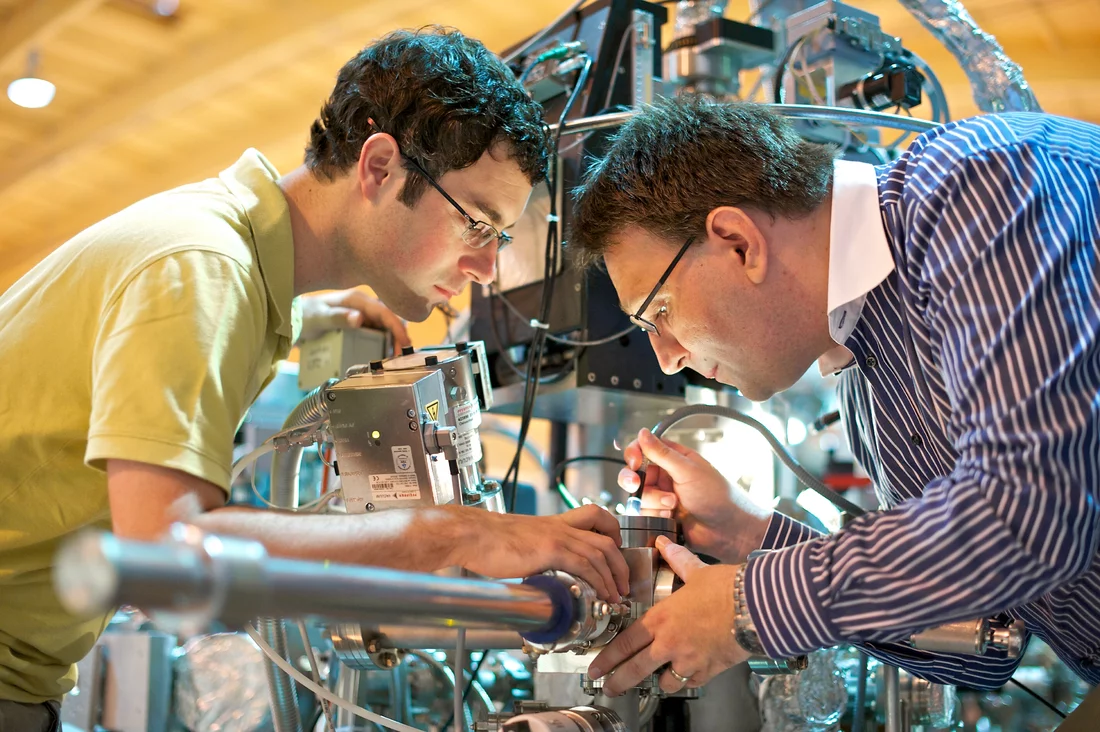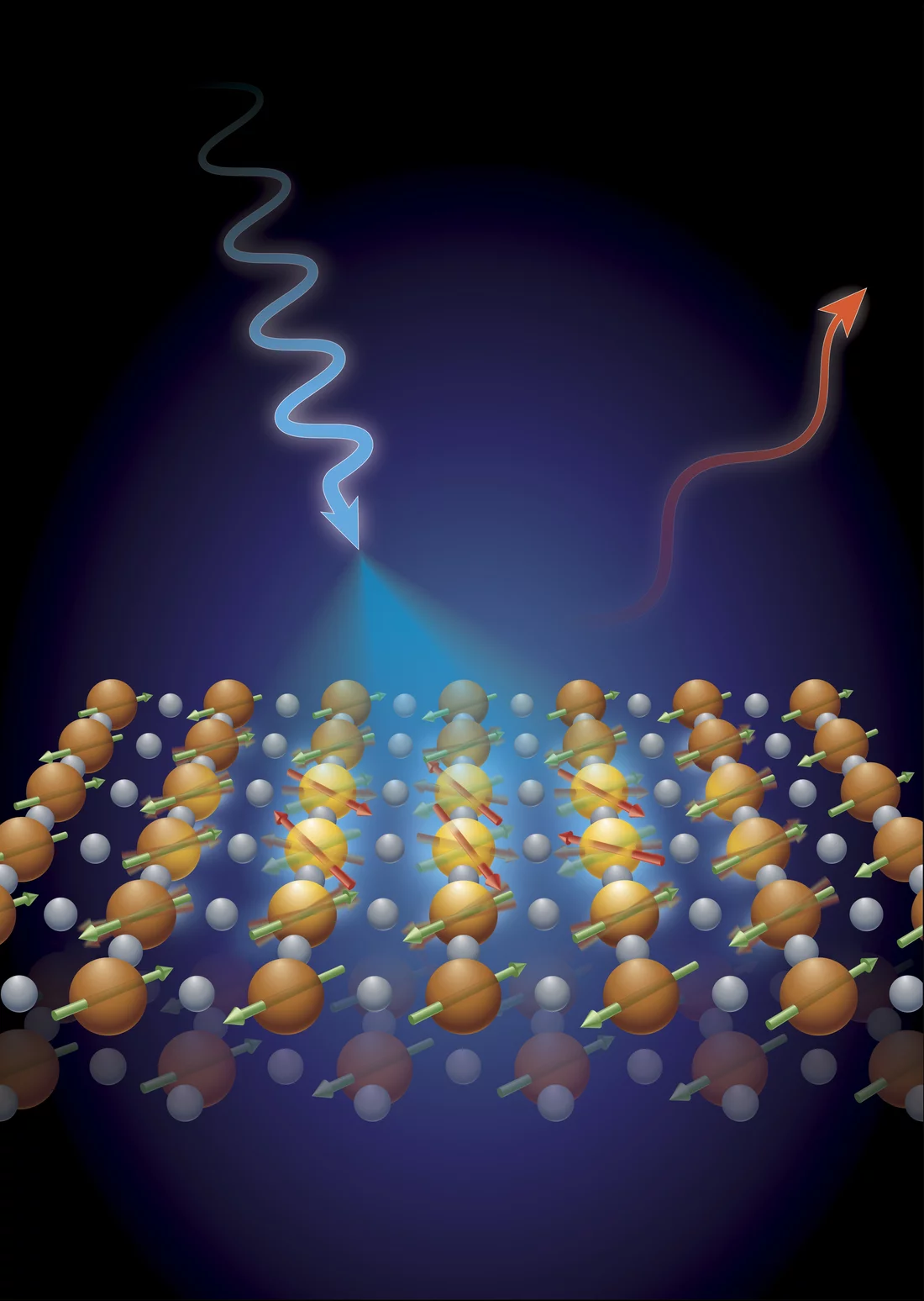An American-Swiss research team has used a new X-ray technique at Swiss Light Source (SLS) of the Paul Scherrer Institute (PSI) to investigate the magnetic properties of atomically thin layers of a parent compound of a high-temperature superconductor. It turns out that the magnetic properties of such thin films differ by only a surprisingly small degree from those of macroscopically thick samples. In their experiment, the researchers investigated the material using X-ray light from the SLS and found out how the energy of the light changed as it passed through the sample. The “RIXS” technique that is available at PSI is the first of its kind that is sensitive enough to enable investigations on such thin films. At the present time, superconducting materials are already being studied by this technique. In the future, it could be used for studying the processes occurring in very thin superconductors and contribute to an understanding of the fascinating phenomenon of high-temperature superconductivity. The results of the present work have recently appeared in the journal Nature Materials.
When electricity flows from a power station into individual homes, some of the energy is dissipated as heat en route due to the resistance of the power cables. However, if power cables could be made of a superconductor – a material which has no resistance to the flow of electricity – then there would be no energy losses during transmission. In particular, this would be very interesting if high-temperature superconductors could be used. This term is a little confusing, though, because such superconductors still have to be cooled to below minus 135°C in order to lose their electrical resistance – a temperature that we do not normally think of as being particularly high! These materials are so named, however, because classical superconductors – which have been known about for much longer – require very much lower temperatures in order to lose their resistance. The physical processes behind the phenomenon of high-temperature superconductivity are still unknown. By investigating these processes, researchers are hoping to gain insights into a fascinating phenomenon of solid-state physics as well as find out how superconductors might be developed that could be employed in every-day technical applications. It might even be possible to create a room-temperature superconductor.
On the Track of understanding High-Temperature Superconductivity
Researchers at the Brookhaven National Laboratory (USA) and the Paul Scherrer Institute (PSI) in Switzerland, together with colleagues from the EPFL at Lausanne, have studied La2CuO4, a so-called parent compound for a high-temperature superconductor. This means that it becomes a superconductor when an appropriate small number of atoms from another element – such as strontium – are mixed with it.
“The most important building blocks of a high-temperature superconductor are two-dimensional films of copper and oxygen atoms”, says physicist Mark Dean from Brookhaven. “Many physicists believe that a magnetic interaction which binds electrons in pairs may be the mechanism which creates superconductivity. An understanding of these magnetic films is therefore essential for finding out how high-temperature superconductivity works.”
Magnetism in thin Superconductor Films
The scientists have now investigated such copper-oxide films individually by inserting another material between them and thereby insulating them from one another. In this way, they were able to study the strength of the interaction between the individual atomic layers on the way the material behaved. Specifically, the researchers were able to observe spin waves. These are produced by the movement of electron spins, which can be imagined as tiny magnets that are attached to individual electrons. “These spins could be of decisive importance for the creation of high-temperature superconductivity”, explains John Hill from Brookhaven. “Understanding the role they play will help us to understand high-temperature superconductivity and to develop superconductors which work at room temperature.”
In a material, electron spins are linked by magnetic forces. When a spin flips inside a magnet, the disturbance propagates through the material as a wave – a spin wave. The researchers have now been able to show in their experiment that the behaviour of spin waves in single layers is only slightly different from that in thicker pieces of material.
Only PSI’s Technique is Sensitive Enough
“For these measurements, we illuminated the material with X-ray light from the Swiss Light Source and measured how the energy of the light that was scattered by the sample differed from that of the incident light. The properties of the spin waves in the material can then be determined from this difference”, explains Thorsten Schmitt, who runs the ADRESS beamline at PSI, where the investigation was carried out. “Because we were only studying single layers, we had just a very small amount of material that could scatter the light and absorb some of its energy. But our facility can measure such a very weak signal.” This method will now allow single layers of other materials to be investigated – such as doped superconductor materials – and so enable us to track down the secret of high-temperature superconductivity.
Many unique Capabilities
It is not just one procedure that enables such results to be achieved. Also essential was the theoretical backup of scientists in the team of Henrik Rønnow at EPFL, Lausanne, who interpreted the results and produced guidelines for future research. Before the experiments were carried out at the SLS, the samples were also studied using muons from the SμS muon source at PSI. Here, low energy muons produced by this unique facility were used to specifically investigate the magnetic properties of thin films. It was possible to determine if the films were truly insulated from each other and did not influence one another. The uniquely thin films that were studied were produced by Brookhaven’s Ivan Božović; the art of creating such thin films is one that no-one else in the world but he has mastered to this degree.
About PSI
The Paul Scherrer Institute develops, builds and operates large, complex research facilities, and makes them available to the national and international research community. The Institute's own key research priorities are in the investigation of matter and material, energy and the environment; and human health. PSI is Switzerland's largest research institution, with 1500 members of staff and an annual budget of approximately 300 million CHF.
Contact
Dr. Thorsten Schmitt; Laboratory of Condensed Matter Physics, Research Department Synchrotron Radiation and NanotechnologyPaul Scherrer Institut, 5232 Villigen PSI, Schweiz
Telephone: +41 56 310 37 62, E-mail: thorsten.schmitt@psi.ch
http://www.psi.ch/sls/adress/
Original publication
Spin excitations in a single La2CuO4 layerM. P. M. Dean, R. S. Springell, C. Monney, K. J. Zhou, J. Pereiro, I. Božović, B. Dalla Piazza, H. M. Rønnow, E. Morenzoni, J. van den Brink, T. Schmitt & J. P. Hill
Nature Materials (2012); doi:10.1038/nmat3409; Published online 02 September 2012


